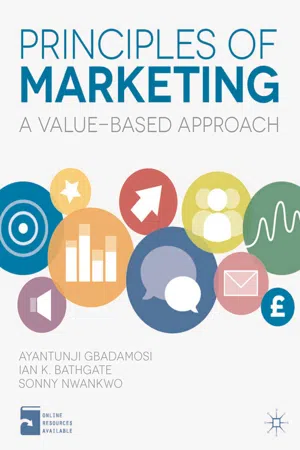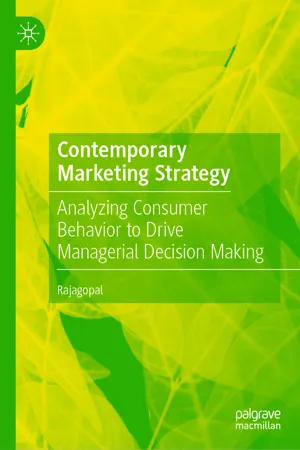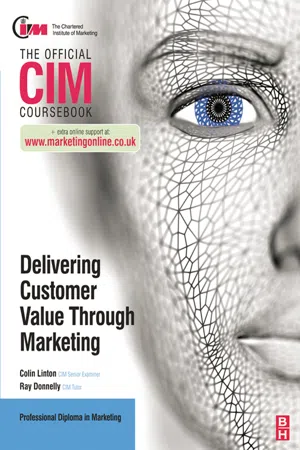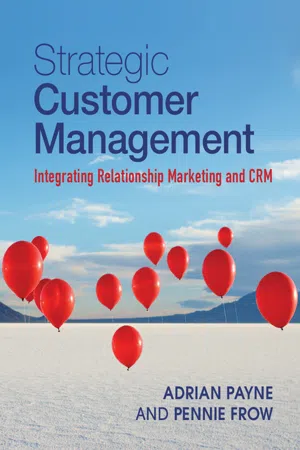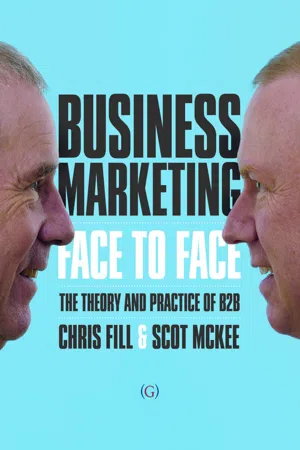Marketing
Channel Strategy
Channel strategy refers to the plan and approach a company uses to reach and engage its target customers through various distribution channels. It involves decisions about which channels to use, how to manage them, and how to optimize their performance. A well-defined channel strategy helps businesses effectively deliver their products or services to the market.
Written by Perlego with AI-assistance
Related key terms
1 of 5
11 Key excerpts on "Channel Strategy"
- eBook - PDF
Principles of Marketing
A Value-Based Approach
- Ayantunji Gbadamosi, Ian Bathgate, Sonny Nwankwo(Authors)
- 2013(Publication Date)
- Bloomsbury Academic(Publisher)
Selective distribution: Selective distribution means that a limited number of outlets are chosen. This reflects either the perceived value of the goods (for example, distri-buting Seiko watches only through high-quality jewellers) or where selection may be on a geographic basis (if, for instance, the marketing strategy is to target only the UK). Exclusive distribution: Exclusive distribution involves the distributor only handling one manufacturer’s products. The major motor manufacturers all operate exclusive dealerships, for example, and Apple has 28 stores in the UK that sell exclusively Apple products. Setting a Channel Strategy is a commitment to the long term. Whilst it is rela-tively easy, for instance, to increase or decrease expenditure on promotions or switch between various media, making changes to the demand chain can take a long time, especially if there are complex contractual negotiations to undertake. Companies may well review their strategy and conclude that they can achieve better results with a shorter, more direct channel and fewer partners. This process is known as disintermediation or, in common parlance , ‘cutting out the middle-man’. Whilst this can be a deliberate strategy, it can also be driven by the consumer. With the growth of web-based retailing, there has developed a new feature of consumer behaviour which the retail industry refers to as ‘showrooming’, in which customers use physical stores to examine a product before buying it somewhere else, either online or via their mobile device, for the sake of cheapness or convenience ( Retail Week Technology , September 2012, pp. 9–10). 246 VALUE-ADDED DISTRIBUTION STRATEGIES selecting channel members Unless the producer is in direct contact with the customer, as would be the case in a business-to-business context when the manufacturer’s salesforce is visiting custom-ers’ premises, the channel network is also the communication link between manu-facturer and customer. - eBook - ePub
Contemporary Marketing Strategy
Analyzing Consumer Behavior to Drive Managerial Decision Making
- Rajagopal(Author)
- 2019(Publication Date)
- Palgrave Macmillan(Publisher)
No single distribution satisfies the needs of every firm, and many organizations use several channels to reach different market segments. The distribution channels include logistics, inventory, and communication services essential to producers, retailers, and consumers. However, companies take help of the advanced technologies toward homogenization of time and distribution locations. The matrix model of distribution suggests how existing firms and entrepreneurs can perform their distribution functions more efficiently. It enables identification of competitors to use the media to change the rules of the marketplace, and helps managers brainstorm (Pitt et al. 1999). Channel design affects the market strength of a company. Designing multiple channels is a contemporary strategy followed by many multinational companies, whereby firms employ different combinations of company sales forces, distributors, sales representatives, catalogs, and the Internet to reach to their customers. Firms operating within highly dynamic, complex, and munificent environments should combine a differentiation strategy with a multiple channel system, in which a large number of independently owned channels are augmented with a relatively larger number of company-owned channels, and in which formal rules and authority are used sparingly (Kabadayi et al. 2007). Distribution channels help manufacturing and marketing companies to conquer the time and distance intervals that divide users from the merchandise they need. Channel Management Strategy The channel structure strategy is about using perspectives of intermediaries in the flow of goods from manufacturers to customers. Distribution may be either direct from manufacturer to retailer or from manufacturer to customer, or indirect involving the use of one or more intermediaries such as wholesalers or agents, to reach the customer - eBook - PDF
- Malcolm McDonald, Ailsa Kolsaker(Authors)
- 2017(Publication Date)
- Red Globe Press(Publisher)
It is vital for the success of the supplier that customers should have 360 CHAPTER 17 – Channel Strategy access to the product or service through channels that meet their requirements as well as the supplier’s. In response to e-commerce, routes to market are being reconfigured in five main ways: ■ product substitution/reconfiguration (such as e-mails instead of physical post); ■ disintermediation (e-commerce can make intermediaries redundant); ■ re-intermediation (a previous intermediary is replaced by a new online intermediary); ■ partial channel substitution (an intermediary’s role may be reduced, but not eliminated – as in the case of a car manufacturer providing customer information, but pointing customers to particular outlets); and ■ media switching/addition (the links in the chain may remain the same, but communication between them may be partially or fully switched to the Internet from the previous mechanisms). Developing relationships with channel intermediaries based on partnership can be a powerful means of building competitive advantage. The aim should be to develop marketing programmes that are attractive to all members of the distribution channel and not just to end users. In a push strategy , attention is concentrated on the intermediary to ‘sell-in’ more products, whereas in a pull strategy , the supplier emphasizes the creation of demand so that intermediaries are encouraged to deal in that product. FURTHER READING Rosenbloom, B. (2012) Marketing Channels: A Marketing View, Mason, USA: South-Western Cengage Learning An exploration of marketing channel strategies and systems combining theoretical perspectives and practical application. REFERENCES Avery, J., Steenburgh, T.J., Deighton, J. and Caravella, M. (2012) Adding Bricks to Clicks: Predicting the Patterns of Cross-Channel Elasticities Over Time, Journal of Marketing, Vol. 76 (May): 96–111. McDonald, M. and Wilson, H. (2002) The New Marketing , Oxford, Butterworth-Heinemann, 2002. 361 - eBook - PDF
- A. Zoltners, P. Sinha, S. Lorimer(Authors)
- 2004(Publication Date)
- Palgrave Macmillan(Publisher)
99 CHAPTER 4 Go-To-Market Strategy How this chapter is organized Introduction 99 Examples of how sellers connect with their customers 100 Developing a successful go-to-market strategy 102 Types of selling channels 102 Selecting the right selling channels 104 Customer needs and preferences influence channel selection 104 The efficiency–effectiveness trade-off 105 Should a high-touch or a low-touch channel be used to execute the sales strategy? 108 Managing “hybrid” channels 111 The role of the sales force in connecting with customers 112 Should the company use a direct or an indirect sales force? 112 When to use an indirect sales force 113 Advantages of selling directly 116 Six go-to-market strategy insights 118 Your go-to-market strategy can be a source of competitive advantage 118 We live in a multi-channel world 119 The role of the sales force is changing 120 A sales strategy change may be necessary if star performers are holding the company hostage 121 Technology is changing the channel structure 121 Go-to-market strategy should be reassessed at least every two years 123 INTRODUCTION Chapter 3 presented a framework for determining a firm’s sales strategy , including the right product and service offering and sales process for each type of customer. Next, the firm must decide which sales and marketing channels are best suited to deliver this sales strategy. This is the firm’s go- to-market strategy, as illustrated in Figure 4.1. Go-to-market broadly refers to how a firm serves its customers with a combination of sales, financing, logistics, and service. In this book and chapter we take a narrower view, focusing on how different parts of the firm’s sales process such as prospecting, qualification, and closing are performed. Successful firms make go-to-market choices that enable effi- cient yet effective connections with their customers and prospects. Many - Ray Donnelly, Colin Linton(Authors)
- 2010(Publication Date)
- Routledge(Publisher)
CHAPTER 5 Channel Management, Distribution Strategies and Control
DOI: 10.4324/9780080961255-7Learning Objectives
At the end of this chapter you will be able to:- Evaluate different channel management and distribution strategies
- Apply management controls to different types of channels domestically and internationally
Introduction
This section of the syllabus introduces the concept of channel management. While touching on the concept of the physical management of the goods from manufacture to the consumer, it is more concerned with the information flows that pass between the different members of the channel. In Chapters 5 , 6 , 7 we will explore how effective distribution channels work, why they are chosen, what makes them effective, and how they can be monitored.Distribution channels are an important consideration for any organisation and, as we will see, the relationship between the various parties can be complex and extend beyond the formal channel relationships into a wider network which still has to be managed.Chapter 5 focuses on the different types of channels and how they are used domestically and overseas.Distribution Channels
Distribution channels refer to a group of individuals or organisations (intermediaries) that move goods from the producer to the consumer or industrial user of the product. In other words a distribution channel is the way an organisation gets its product to the consumer. Sometimes distribution channels are referred as marketing channels.Distribution channels do not just involve physical products, but can equally apply to services which tend to have a shorter channel. Channels can extend beyond geographical boundaries and have an important role to play in overseas markets.- eBook - PDF
Strategic Customer Management
Integrating Relationship Marketing and CRM
- Adrian Payne, Pennie Frow(Authors)
- 2013(Publication Date)
- Cambridge University Press(Publisher)
Building a multi-Channel Strategy Building a multi-Channel Strategy involves a channel design that offers the greatest value for the customer and the company. This involves assessing the value created for the end consumer by different channels structures, understanding the economics of different MULTI-CHANNEL INTEGRATION 329 channel structures and determining the Channel Strategy that will create the maximum value for consumers and the greatest pro fi t for the company. Developing a multi-Channel Strategy that delivers an appropriate customer experience for a company ’ s main customer segments includes a number of key activities: develop strategic multi-channel objectives; understand the needs and concerns of key customer segments; undertake a strategic review of industry structure and channel options; understand shifts in channel usage patterns; review channel economics; develop an integrated channel management strategy. Drawing on earlier discussions, each of these activities is now reviewed. Develop strategic multi-channel objectives The starting point for formulating a multi-Channel Strategy is to determine the key strategic objectives. The overall objective of multi-channel integration is to provide a signi fi cantly enhanced customer experience resulting in higher customer satisfaction and increased sales, pro fi ts and share of wallet. Ideally, this should be accompanied by a lower cost to serve, through alternative channels, for example, from direct sales force to desk-based account management, or from desk-based account management to the adoption or an increase in the use of electronic solutions. Speci fi c strategic objectives should be developed by a company to re fl ect the earlier CRM strategy development and value creation processes. - Bryan Jean, Jyh-Shen Chiou, Shaoming Zou, Bryan Jean, Jyh-Shen Chiou, Shaoming Zou(Authors)
- 2013(Publication Date)
- Emerald Group Publishing Limited(Publisher)
LITERATURE REVIEW Managing marketing mix is important to firms. Among product, price, place, and distribution, channel management is particularly challenging for sales subsidiaries in host countries. Marketing channel or distribution channel can be regarded as the process of transferring particular products or services from producers to consumers ( EI-Ansary & Stern, 1972 ). There are two general research areas of marketing channels ( Ensign, 2006 ): one relates to the structure of a channel, answering the question of how the channel is generally organized to fulfill its basic purpose of creating value for a firm’s customers, while the other relates to the behavior dimensions of the channel, addressing the question of how channel members perceive, build, and deal with inter-firm relationships that exist within the channel. The relevant literature regarding these two streams of research is reviewed in this section. Channel Structure In early days, most academics applied the transaction cost theory (TCE) to discuss ‘‘make-or-buy’’ issues ( Coase, 1937; Williamson, 1979, 1981 ) Channel Strategies of Foreign Sales Subsidiaries 131 due to the phenomenon that when designing distribution system, manufacturers often choose one type of Channel Strategy, either direct Channel Strategy or indirect Channel Strategy. The former refers to selling products directly to customers, while the latter means delegating the task to other intermediaries or independent distributors. The TCE argues that when making the make-or-buy decision, firms need to take into account both the sales volume and possibility of being taking advantage by other firms. By using the TCE perspective, Anderson and Coughlan (1987) and Kim and Daniels (1991) pointed out that ownership of transaction-specific assets, service requirements, product differentiation, cultural similarly, etc., would be more likely for a manufacturer to adopt a direct selling approach.- eBook - PDF
- Chris Fill, Scot McKee(Authors)
- 2011(Publication Date)
- Goodfellow Publishers(Publisher)
Summary Here are the key points about the B2B marketing channels, set out against the learning objectives. 1 Define the nature and concept of marketing channels. Marketing channels, also called distribution channels, are concerned with the interor-ganisational management of the processes and activities involved in moving products from manufacturers to end-user customers. Marketing channels consist of a chain of organisations that collectively develop prod-ucts and services. Each adds something of value before passing it to the next, in order that the product or service be offered in the most convenient and valued format for end-user purchase and consumption. Marketing Channels 6 175 2 Examine the purpose of, and tasks associated with, marketing channels. Marketing channels exist because they provide a means by which uncertainties can be reduced or shared. By combining with other organisations who have different specialised skills (for example customer access, finance, transportation, storage) these uncertainties can be diminished. The added value provided by each of these organi-sations contributes to the superior value perceived by end-users and contributes to competitive advantage. 3 Appraise the significance of service output theory and explain how it can be used to reduce channel member uncertainty. Channels should be designed to meet end-user customer needs as they seek utility from marketing channels. This utility can be observed in many forms but is essentially concerned with levels of service provided by a channel. Customers are more likely to be attracted to channels that offer higher levels of service. Channel service consists of four main elements: unit size, spatial convenience, waiting time and product variety. 4 Consider ideas concerning channel flows. Interorganisational coordination requires that there is flow of processes that sweep up and down the channel in order that all participants are able to undertake their roles effectively and efficiently. - eBook - PDF
Direct Marketing in Action
Cutting-Edge Strategies for Finding and Keeping the Best Customers
- Andrew R. Thomas, Dale M. Lewison, William J. Hauser, Linda M. Orr, Andrew R. Thomas, Dale M. Lewison, William J. Hauser, Linda M. Orr(Authors)
- 2006(Publication Date)
- Praeger(Publisher)
Chapter 10 DIRECT MARKETING CHANNELS: SELECTING AND EMPLOYING THE RIGHT MEDIA Bruce D. Keillor The best product in the world is worthless if you can’t get it to your customer. —Henry Ford As we have seen in the previous chapters, the whole notion of direct marketing goes well beyond the image of ‘‘bothersome’’ marketing that exists in the minds of many people, business, and customers alike. Just as the old-school approach of communicating to masses of potential customers through, say, television, or radio ads is no longer universally effective, neither is the stereotype of direct mar- keting being the annoying phone call at dinner time. Truly effective marketing must have the targeted, creative, customized qualities that define direct marketing in the twenty-first century. This brings us to the problem of actually employing direct marketing activities to suc- cessfully gain access to customers. In this chapter, we will explore how direct marketing has changed the concept of marketing ‘‘channels,’’ or the means through which the firm gains access to customers, and how winning companies can begin to create a first- class direct marketing Channel Strategy. In the past, any discussion of marketing channels was all about how a firm could construct a distribution network that would bridge the gap between the product’s location and the customer. The focus was on physical distribution and logistics that, by their very nature, create both a tangible and intangible breech between the firm and its customers making relationship management exceedingly difficult. This meant dealing with wholesalers, retailers, physical distribution, inventory control, and all the hundreds, perhaps thousands, of related logistical challenges that go along with ‘‘moving product.’’ In the new world of direct marketing, some of these variables (like wholesalers) can drop out of the equation, others (like retailing) take on a new look, while still others (like inventory control) have to be adapted. - eBook - PDF
- Louis E. Boone, David L. Kurtz, Michael H. Khan, Brahm Canzer, Rosalie Harms, Peter Moreira(Authors)
- 2023(Publication Date)
- Wiley(Publisher)
Judgment Call 13.7 Distribution Channel Decisions and Logistics 387 13.7 Distribution Channel Decisions and Logistics Every company faces two major decisions when choosing how to distribute its goods or services: selecting a specific distribution channel and deciding on the level of distribution intensity. In deciding which distribution channel is most efficient, business managers need to consider four factors: the market, the product, the producer, and the competition. These fac- tors are often interrelated and may change over time. In today’s global business environment, strong relationships with customers and suppliers are important for survival. Selecting Distribution Channels Market factors may be the most important consideration when choosing a distribution channel. When a firm needs to reach a target market of a small number of buyers or buyers within a small geographical area, the best option may be a direct channel. In contrast, if the firm must reach customers who live in a wide geographical area or who make frequent small purchases, then the channel may need to use marketing intermediaries to make goods avail- able when and where customers want them. In general, most standardized products or items with low unit values use relatively long distribution channels. On the other hand, products that are complex, expensive, custom- made, or perishable move through shorter distribution channels involving few—or no— intermediaries. The increasing use of e-commerce is resulting in changes in traditional distribution practices. The European Commission issued an interesting set of rules, effec- tive until 2022. These rules allow makers of goods with less than a 30 percent market share—usually high-end manufacturers—to block internet-only retailers from carrying their products. The commission declared that “suppliers should normally be free to decide on the number and type of distributors they want to have in their distribution systems. - eBook - PDF
- Harvard Business Review, Alvin J. Silk(Authors)
- 2006(Publication Date)
- Harvard Business Review Press(Publisher)
Because channels involve complex legal relationships, they can be difficult to adjust, and flexibility should be a criterion in judging a proposed structure. 5 Additional Readings on Channel Management and Go-to-Market Strategy Aaker, David A., and Erich Joachimsthaler. “The Lure of Global Brand-ing.” Harvard Business Review , November 1999. The authors offer four prescriptions for companies seeking to launch global brands. Anderson, Rolph, Rajiv Mehta, and Alan J. Dubinsky. “Will the Real Channel Manager Please Stand Up?” Business Horizons , January 15, 2003. Based on a national study and a systematic review of the litera-ture, this article identifies who actually manages go-to-market channels. Dell, Michael, and Joan Magretta. “The Power of Virtual Integration: An Interview with Dell Computer’s Michael Dell.” Harvard Business Review , March 1998. This McKinsey Award–winning article explores Michael Dell’s highly innovative way of combing the individual pieces of Dell Computer’s strategy—Dell’s customer focus, supplier partnerships, mass customization, just-in-time manufacturing—where technology-enabled coordination across company boundaries has achieved new levels of ef-ficiency, productivity, customer satisfaction, and shareholder value. 6 Nunes, Paul F., and Frank V. Cespedes. “The Customer Has Escaped.” Harvard Business Review , November 2003. The authors urge companies to design pathways across channels to help their customers get what they need at each stage of the buying process, designing one’s go-to-market strategy for buyer behaviors, not customer segments. 130 Developing Marketing Strategies Notes 1. Additional Readings were added to this chapter. They did not ap-pear in the Class Note. Notes 2 through 4 below appeared as footnotes in the Class Note but were lightly edited for consistency. 2. R. T. Moriarty and U. Moran, “Managing Hybrid Marketing Sys-tems,” Harvard Business Review , November–December 1990.
Index pages curate the most relevant extracts from our library of academic textbooks. They’ve been created using an in-house natural language model (NLM), each adding context and meaning to key research topics.
